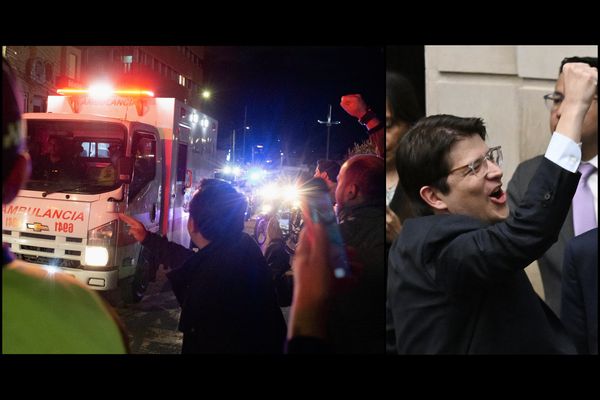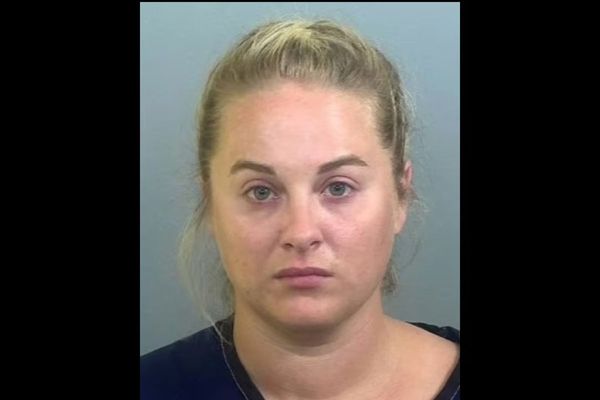
Thirty years ago this summer, at 4.30 one Thursday afternoon, a 15-year-old schoolgirl called Dawn Ashworth set off from a friend’s house in the village of Narborough, Leicestershire, and began to walk home. Dawn lived in the nearby village of Enderby, a few minutes’ walk away, and chose to take a short-cut along a footpath known locally as Ten Pound Lane. And then she vanished. It was not until two days later that Dawn’s body was found in the corner of a nearby field, covered in twigs, branches and torn-up nettles. The pathologist established that she had put up a considerable struggle before being raped and strangled.
The hunt for Dawn’s killer was unlike any previous murder investigation, however: it was conducted with the help of a new science. The technique known as DNA fingerprinting was employed in a criminal investigation for the first time. Not only did this revolutionary technique lead, indirectly, to the killer being caught; it also prevented a grave miscarriage of justice. And it was employed in a manner that would, today, be likely to face resistance from some members of the public.
As soon as Dawn’s body was found, the police realised that they were looking for a serial killer: two-and-a-half years earlier, another 15-year-old, Lynda Mann, had been murdered a few hundred yards from the scene of Dawn’s murder. Lynda’s clothes had been removed in the same manner as Dawn’s, and she too had been raped before being strangled with her own scarf. Detectives also believed that the killer was a local man, someone who knew the area, and possibly knew Lynda.
Narborough and the surrounding villages were paralysed with fear. In an editorial headlined “Killer in our midst”, the Leicester Mercury warned: “If we don’t catch him it could be your daughter next.” The vicar of Enderby, Canon Alan Green, urged the murderer to give himself up, “because at some time in the future you will have to face your creator and account for the terrible thing you have done”.
While the police had been unable to find Lynda’s killer, they quickly made an arrest after the discovery of Dawn’s body.

Richard Buckland, a 17-year-old Narborough boy with learning difficulties, and who knew Dawn, appeared to have knowledge of some details of the crime that had not been made public. Under questioning he would repeatedly admit the crime, and then withdraw the admission. On 10 August he was charged with Dawn’s murder, and appeared in court the following day.
Buckland refused to confess to the murder of Lynda, however. He was adamant that he was not guilty of that crime. The police, in their certainty that both girls’ lives had been taken by the same person, were convinced he was lying.
Meanwhile, five miles north-west of Narborough, at the University of Leicester, geneticist Alec Jeffreys had made a remarkable – and quite accidental – discovery during a failed experiment to study the way in which inherited illnesses pass through families. He had extracted DNA from cells and attached it to photographic film, which was then left in a photographic developing tank. Once extracted, the film showed a sequence of bars: Jeffreys quickly realised that every individual whose cells had been used in the experiment could be identified with great precision. Furthermore, the technique could be used to determine kinship.
After publishing an academic paper on his discovery, Jeffreys had been asked to assist with a number of cases in which children were being denied British citizenship because immigration officials were disputing that they were the offspring of British parents. But DNA fingerprinting had yet to be used in a criminal investigation. When Jeffreys gave his first talk about his discovery and suggested that it could be used to apprehend criminals, some in the audience had laughed out loud.
But after Buckland’s court appearance, Jeffreys received an unexpected call from the police, asking him whether his new science could prove that the youth had murdered Lynda as well as Dawn.
Jeffreys agreed to carry out tests on Buckland’s blood and on semen taken from the dead girls’ bodies, and worked through the night to finish the work. When he took the film from the developing tank, he could see immediately that the girls had been raped by the same man – and also that Buckland’s DNA was completely different. He had to tell the police that although they were correct in their belief that one man had raped and murdered both girls, not only had Buckland not killed Lynda, he had not killed Dawn either.

The police were astonished, and initially reluctant to believe what they were hearing. Jeffreys’ test was repeated, and then run a third time. “One minute we got the guy,” the senior investigating officer is said to have muttered, “and the next we’ve got Jack shit.”
Buckland, clearly innocent, was set free – after more than three months in custody – and the police were back at square one in their hunt for a highly-dangerous double killer.
The following month, the detectives decided that the technology that had exonerated Buckland should be used to catch the killer. They would screen the entire neighbourhood: they would set up an operation to gather the DNA of every man in the area. Letters were sent to every male born between 1953 and 1970, who had lived or worked in the Narborough area in recent years, asking them to agree to give a blood sample. Two testing centres were established, in a local school and a council office, and there were two testing sessions, morning and evening, three days a week. Each man was expected to bring proof of identity.
It was a voluntary scheme, and a few men declined, some saying they did not like needles, one or two saying they did not like police officers. But most of these men soon changed their minds. The horror at the crimes – and the fear that the killer could strike again – resulted in those with reservations coming under considerable social pressure. By the end of the month, around 1,000 men had volunteered to give samples, and the forensic science laboratories that were conducting the tests were struggling to keep up.
The process quickly drew national and international attention. “Police investigating the murders of two teenage girls near this small Midlands village are applying a new scientific technique,” reported the Los Angeles Times. “Some predict [it] could be the most significant breakthrough in resolving serious crime since fingerprinting was invented.”

There were complaints from some, with the National Council for Civil Liberties – as the UK rights group Liberty was formerly known – highlighting the risk of human error and suggesting that parliament needed to consider the implications of mass screening programmes. But as the LA Times put it: “A strong sense of community outrage among close-knit villagers and an effective police public relations campaign effectively overcame apprehensions among some residents that the tests were an invasion of their personal rights.”
After eight months, 5,511 men had given blood samples and only one had refused. But there was no match with the semen samples. Police began to expand the hunt.
Among those who were recorded as having given a sample was Colin Pitchfork, a 27-year-old baker and father of two young children. Three years earlier, he had been questioned about his movements on the evening that Lynda had been murdered. He had said, quite correctly, that he had been looking after his young son.
In August 1987, more than a year after the killing of Dawn, one of Pitchfork’s workmates, a man called Kelly, was having a pint with a few friends in a pub in Leicester. The conversation turned to Pitchfork, and Kelly confessed that he had impersonated him, in order to take the blood test on his behalf. Kelly explained that Pitchfork had asked for this favour because he had already taken the test, for a friend who had a conviction for indecent exposure when he was younger. Pitchfork had doctored his passport, inserting Kelly’s photograph, and then driven him to the test centre at the school, waiting outside while the blood sample was taken.
Six weeks later, one of the people in the pub relayed this conversation to a local policeman. Kelly was promptly arrested, and by the end of the day Pitchfork was also in custody. After reading him his rights, a detective asked: “Why Dawn Ashworth?”
Pitchfork is said to have shrugged and replied: “Opportunity. She was there and I was there.”

He then gave a detailed confession to both murders and two other sexual assaults. When he raped and killed Lynda Mann, his car had been parked nearby, and his baby son had been asleep in the back of it. DNA testing confirmed him as the double killer.
The following January Pitchfork appeared at Leicester crown court, where he pleaded guilty to two counts of murder, two of rape, two of indecent assault and one count of conspiring to pervert the course of justice.
The court was provided with a psychiatric report that recorded a “personality disorder of psychopathic type accompanied by serious psychosexual pathology” and warned that Pitchfork “will obviously continue to be an extremely dangerous individual while the psychopathology continues”. He was sentenced to life imprisonment, and in accordance with the practice at that time, the home secretary, Douglas Hurd, set his minimum term: 30 years.
Although Jeffreys’ work almost certainly saved Buckland from suffering a serious miscarriage of justice, Pitchfork’s guilty pleas meant that DNA evidence was not relied upon by the prosecution, and this new science was not tested by the court. But the investigative potential of the technique was rapidly recognised and embraced by police forces around the globe. The Home Office took immediate steps to ensure sufficient numbers of technicians and forensic scientists were trained to allow DNA profiling to be incorporated routinely into police casework.
Over the last 30 years, according to some estimates, more than 50 million people have had their DNA tested during criminal investigations. It has secured the convictions of perhaps millions of criminals and, from time to time, excluded innocent suspects like Buckland, and overturned miscarriages of justice.
There have also been occasional mass DNA dragnets in Australia, Canada, France, Germany, the Netherlands, the US and elsewhere, but in recent years, police forces have been less likely to use the mass screening programmes of the type that led, indirectly, to the apprehension of Pitchfork.

The Leicestershire detectives conceded at the time of their DNA sweep that while they were able to persuade thousands living in a small – and shocked – rural community to co-operate, they would not have encountered the same response if the murders had happened in a city.
Jeremy Gans, a professor at Melbourne Law School who has studied DNA dragnets, believes the main reason such sweeps are now uncommon may be because many countries have created large, standing DNA databases. “The police, like almost everyone else, think that if you’re looking for someone who has committed a serious crime, you are looking for someone who has had prior contact with the police.”
The first national DNA database was established in the UK in 1995. It currently holds 5.8 million DNA profiles based on samples taken from 5.1 million people – equivalent to almost 8% of the population.
Gans says that other reasons why DNA sweeps may no longer be deemed useful include the ease with which police can obtain DNA from suspects – such as by following them until they discard a soft drink can – and the development of the technique to the point where a match to a crime scene sample can be made through samples taken from relatives of the criminal.
It is also possible that police forces in the UK became less interested in gathering large numbers of samples following the introduction of new legislation in 2012 that provided for the eventual destruction of most DNA profiles based on samples taken from people who were not convicted of a crime. The law was introduced to address concerns that the retention of the DNA records of everyone who was arrested - regardless of whether they were eventually charged and prosecuted - risked undermining public support for the national DNA database.
Alec – by now Professor – Jeffreys had supported this reform. By this time, he had became known as the father of genetic fingerprinting. In 1994 he was knighted for services to science and technology and four years ago he retired from the university.
Friends of Lynda and Dawn, meanwhile, have set up a web page in memory of the girls. People from the area add their recollections, and use the site to lobby against the release of Pitchfork.
In prison, Pitchfork is said to have been well behaved, has been educated to degree level, and has become a specialist in the transcription of printed music into Braille. In April this year he appeared before the parole board, which recommended that he be moved to an open prison, but not released.
Not surprisingly, Lynda’s mother, Kath Eastwood, was unimpressed. “He may have a degree,” she told the Mercury, “but he is also a double child murderer and rapist. You can say he is a well-behaved prisoner, but don’t ever forget that he is a well-behaved double child killer.”
Strands of evidence: famous DNA cases

• In 1990 Alec Jeffreys established that DNA taken from a femur recovered from a Brazilian graveyard was almost certainly that of Josef Mengele, a former SS officer and physician who subjected Auschwitz inmates to grotesque medical experiments. The match was made with samples taken from Mengele’s relatives, who declined to accept his remains.
• A year later scientists were able to prove that skeletal remains found in a burial pit in Yekaterinburg, 850 miles east of Moscow, were those of Russia’s last tsar, Nicholas II, and his wife and children. They had all been killed in 1918, during the Russian civil war. Matches were made with samples taken from several people related to the family, including the Duke of Edinburgh.
• In the US, at least 17 death row inmates have been freed after being exonerated by new DNA evidence. One of them, Henry McCollum, had served 31 years behind bars.
• Familial DNA matches are increasingly bringing criminals to justice long after the crimes were committed. Last month Christopher Hampton, 64, was jailed for life at Bristol crown court after admitting that he had raped a 17-year-old girl and stabbed her to death in 1984. Samples taken from the crime scene were found to match DNA taken from Hampton’s daughter after she was arrested during a domestic dispute.
• This article was amended on 8 June 2016. An earlier version stated that Pitchfork had doctored Kelly’s passport, inserting his own photograph. It was in fact the other way round: Pitchfork doctored his own passport, inserting Kelly’s photograph.







